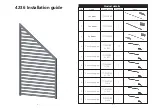
INTRODUCTION
The PAS Vr. Alcohol Screening and Verification System is an advanced portable breath alcohol tester
(PBT) that features both passive alcohol screening and direct measurements with the flip of a switch.
This hand-held analyzer provides both color coded LED's and numeric readout. Individuals who have
been trained in the administration of alcohol screening devices recommend this product.
The PAS Vr. is used to check breath alcohol levels with or without a subject's direct participation or
cooperation. When used without the subject's direct participation it's known as
passive
breath sampling,
as opposed to
active or direct
testing where the subject blows directly into a mouthpiece or the intake
port. The PAS Vr. can also be used to detect alcohol from
open containers
, or to detect low levels of
alcohol in
enclosed spaces
such as
vehicles, lockers
or
classrooms
. The PAS Vr. functions as an
"extension of the operator's nose."
The operator controlled sampling system with mouthpiece guarantees a precise and tamper proof
measurement of the breath sample. The PAS Vr. is especially suited for quick subsequent
measurements.
Testing for Alcohol
The common testing medium for drugs is urine, but using a urine sample for quantitative analysis to
determine a blood alcohol level is not defensible without rigid adherence to complex test procedures.
Blood and urine sample results are available only after a forensic laboratory analysis has been
completed. This can take hours or weeks at a substantial cost. A breath test offers important advantages
by providing immediate results at a cost of pennies per sample. Whether breath tests are used for
screening or evidential purposes, breath alcohol testing offers an accurate, simple, and non-invasive
testing alternative.
A breath sample is easy to obtain, takes less than a minute to analyze, and with proper instrumentation
and training, produces evidentially acceptable results. The procedure is sanitary and inexpensive using
a disposable mouthpiece. Or, alternatively simply
"sniffing"
(screening) for the presence of alcohol
initially by passive sampling, followed by a more exacting measurement using a disposable mouthpiece.
The American Medical Association has demonstrated that a blood alcohol concentration (BAC) of .04
percent impairs an individual to some degree. Impairment can occur at even lower levels in some
individuals. As a result, industries that test for alcohol have chosen to use either .04 or zero BrAC as
maximum acceptable levels in the workplace. In Zero Tolerance states, anyone under the age of 21
caught driving with any amount of alcohol is considered illegal. In correctional institutions and prisons no
alcohol is allowed so instrumentation that can quickly and accurately sample inmates, staff, visitors and
enclosed spaces for alcohol can be invaluable.
1






































